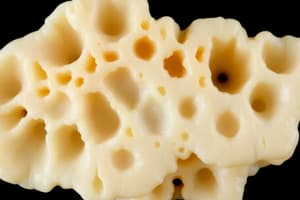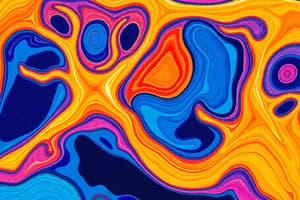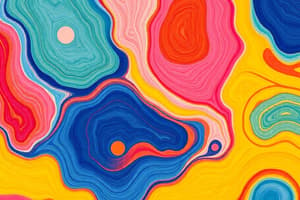Podcast
Questions and Answers
Which characteristic does a scaffold need to have for effective cartilage tissue engineering?
Which characteristic does a scaffold need to have for effective cartilage tissue engineering?
- It must be composed entirely of organic materials.
- It must withstand mechanical forces during tissue regeneration. (correct)
- It should contain high levels of moisture at all times.
- It requires a smooth surface to minimize cell attachment.
What is a key requirement for biomaterials used in cartilage regeneration?
What is a key requirement for biomaterials used in cartilage regeneration?
- Compressive strength less than that of native cartilage.
- Complete biodegradability before cell support is provided.
- Long-term durability and compatibility with natural cartilage. (correct)
- High inflammatory response to promote healing.
How do the geometric parameters of a scaffold influence tissue formation?
How do the geometric parameters of a scaffold influence tissue formation?
- They affect cell-seeding efficiency and nutrient diffusion. (correct)
- They impact the pH levels within the scaffold.
- They primarily control the color and appearance of the scaffold.
- They determine the electrical conductivity of the materials.
What role does the extracellular matrix (ECM) play in cartilage?
What role does the extracellular matrix (ECM) play in cartilage?
Which factor is NOT critical for effective chondrogenesis in tissue engineering?
Which factor is NOT critical for effective chondrogenesis in tissue engineering?
Which type of cartilage is primarily affected by osteoarthritis in the human body?
Which type of cartilage is primarily affected by osteoarthritis in the human body?
What is the primary component of the cartilage's extracellular matrix (ECM)?
What is the primary component of the cartilage's extracellular matrix (ECM)?
Which of the following describes the primary function of articular cartilage?
Which of the following describes the primary function of articular cartilage?
During chondrogenesis, which cells primarily contribute to cartilage formation?
During chondrogenesis, which cells primarily contribute to cartilage formation?
What is a common cause of cartilage defects related to lifestyle?
What is a common cause of cartilage defects related to lifestyle?
Which protein is NOT typically found in the extracellular matrix of cartilage?
Which protein is NOT typically found in the extracellular matrix of cartilage?
Which zone of cartilage has the least proteoglycan content?
Which zone of cartilage has the least proteoglycan content?
What disease primarily causes inflammation of the cartilage connecting ribs to the breastbone?
What disease primarily causes inflammation of the cartilage connecting ribs to the breastbone?
Which type of cartilage provides the support and flexibility needed in the respiratory system?
Which type of cartilage provides the support and flexibility needed in the respiratory system?
What percentage of disabled individuals aged 30 years and older is affected by cartilage-related disabilities?
What percentage of disabled individuals aged 30 years and older is affected by cartilage-related disabilities?
Which type of cartilage is primarily composed of type II collagen fibers and serves as a precursor to bone?
Which type of cartilage is primarily composed of type II collagen fibers and serves as a precursor to bone?
What characterizes the middle zone collagen fibers within cartilage?
What characterizes the middle zone collagen fibers within cartilage?
Which type of cartilage is known for its strength due to dense collagen fibers oriented along functional stresses?
Which type of cartilage is known for its strength due to dense collagen fibers oriented along functional stresses?
In which type of cartilage do chondrocytes reside within a network of elastic fibers, contributing to its elasticity?
In which type of cartilage do chondrocytes reside within a network of elastic fibers, contributing to its elasticity?
What is the primary extracellular matrix composition of hyaline cartilage?
What is the primary extracellular matrix composition of hyaline cartilage?
How does cartilage damage relate to osteoarthritis?
How does cartilage damage relate to osteoarthritis?
Which cartilage type is least likely to be found in structures requiring structural support and flexibility, such as the external ear?
Which cartilage type is least likely to be found in structures requiring structural support and flexibility, such as the external ear?
Study Notes
Cartilage Structure
- Collagen fibers in superficial zone run parallel to surface
- Middle zone collagen fibers are unaligned and tangential to surface
- Deep zone fibers are radially arranged
- Calcified zone fibers are mineralized and arborize with little organization
Hyaline Cartilage
- Glassy appearance when fresh
- Basophilic in H&E sections
- Contains widely dispersed fine collagen fibres (type II)
- Found in ribs, nose, larynx, trachea, and acts as a precursor to bone
Fibrocartilage
- Strongest type of cartilage
- Alternating layers of hyaline cartilage matrix with thick collagen fibers
- Collagen fibers are oriented in direction of functional stresses
- Located in intervertebral discs, joint capsules, and ligaments
Elastic Cartilage
- Chondrocytes are found in a threadlike network of elastic fibres within the matrix
- Provides strength and elasticity; maintains the shape of certain structures
- Found in the external ear, epiglottis, and larynx
Clinical Problem: Causes of Cartilage Defects
- Accidents: sports injuries, heavy impact on joints, wear and tear, lack of movement
- Diseases: osteoarthritis, costochondritis, cartilage removal due to tumors, genetic disorders
Cartilage Structure in the Human Body
- Avascular, lacks nerves and lymphatics
- Composed of extracellular matrix (ECM) and sparsely distributed chondrocytes
- ECM is mainly composed of water, collagen, proteoglycans, and other proteins
- Zones vary in structural properties, functional properties, mechanical properties, stimuli response and protein secretion by cells
Scaffolds for Cartilage Regeneration
- Act as template for cell retention and ECM accumulation
- Must bear the harsh mechanical environment of the joint repair site
- Should not cause inflammatory or immunogenic responses
- Requires a 3D structure to conserve chondrocytic phenotype
Scaffolds (II)
- Geometric parameters affect new tissue formation (porosity, pore size, interconnectivity)
- Influences cell seeding, nutrient and by-product diffusion, and ECM accumulation
- Enhanced mechanical properties influence cell differentiation and phenotype
- Must withstand forces during initial joint loading while protecting cells
Biomaterials in Cartilage Regeneration
- Mimic cartilage due to its avascularity and low cell density
- Fundamental criteria include:
- Consistent mechanical properties with native cartilage (compressive strength, lack of friction)
- Integration with adjacent cartilage
- Durability
- Biodegradability (after providing support, without adverse effects)
- Biocompatibility
Studying That Suits You
Use AI to generate personalized quizzes and flashcards to suit your learning preferences.
Related Documents
Description
Test your knowledge on the structure and types of cartilage including hyaline, fibrocartilage, and elastic cartilage. This quiz covers their characteristics, locations, and functions. Perfect for biology students or anyone interested in human anatomy.




